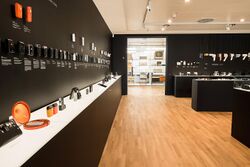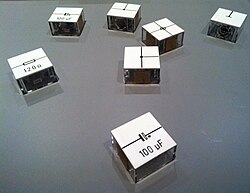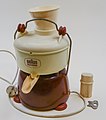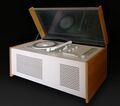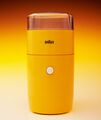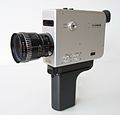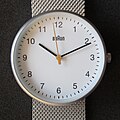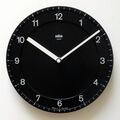Braun
Topic: Company
 From HandWiki - Reading time: 10 min
From HandWiki - Reading time: 10 min
 | |
 | |
| Type | Subsidiary |
|---|---|
| Industry | Manufacturing |
| Founded | 1921 (as Braun AG) in Frankfurt, Germany |
| Founder | Max Braun |
| Headquarters | Kronberg im Taunus , Germany |
Area served | Worldwide |
Key people | Alessandra Dolfini, Global Braun & Venus Vice President Oliver Grabes, Head of Design Dieter Rams, Head of Design (1961–1995) |
| Products | Electric razors Hair care appliances Epilators Electric toothbrushes Watches |
| Owner | Procter & Gamble (brand name & grooming products) Licensees: De'Longhi (small appliances) Kaz Incorporated (thermometers) Zeon Ltd. (clocks, watches & calculators) |
| Website | www |
Braun GmbH (/braʊn/ (![]() listen) "brown"; German: [bʁaʊn] (
listen) "brown"; German: [bʁaʊn] (![]() listen)) is a German consumer products company founded in 1921 and based in Kronberg im Taunus. The company is known for its design aesthetic from the 1960s through the 1980s, which included products such as electric shavers, radiograms and record players, movie cameras, slide projectors, clocks, and small kitchen appliances.
listen)) is a German consumer products company founded in 1921 and based in Kronberg im Taunus. The company is known for its design aesthetic from the 1960s through the 1980s, which included products such as electric shavers, radiograms and record players, movie cameras, slide projectors, clocks, and small kitchen appliances.
From 1984 until 2007, Braun was a wholly owned subsidiary of Gillette, which had purchased a controlling interest in the company in 1967. Braun is now a subsidiary of Procter & Gamble, which acquired Gillette in 2005.[1]
History
In 1921, Max Braun (engineer) (de) (1890–1951), a mechanical engineer, established a small engineering shop in Frankfurt, Germany.[2] In 1923, he began producing components for radio sets. By 1928, the company had grown to such an extent, partly due to the use of certain plastic materials, that it moved to new premises on Idsteiner Strasse.
In 1929, eight years after he started his shop, Max Braun began to manufacture entire radio sets, and his company eventually became one of Germany's leading radio manufacturers. This development continued with the launch of one of the first combined radio and record players, or radiograms, in 1932.
In 1935,[3] the Braun brand was introduced, and the original incarnation of the logotype with the raised "A"[4] was born. At the 1937 World's Fair in Paris, Max Braun received the award For special achievements in phonography. During World War II, Braun was compelled to more or less abandon products for the civilian sector.[5] In 1944, the Frankfurt factories were almost destroyed, and Max Braun began to rebuild his company.[5]
After the war, Braun continued to produce state-of-the-art radios and audio equipment, and the company soon became well known for its "high-fidelity" audio and record players, including the famous SK line. Braun was the only foreign licensee of the QUAD electrostatic loudspeaker for a time. In 1954, the company also began producing film slide projectors, a mainstay of its business for the next forty years. By 1956, Braun was marketing the first fully automatic tray film slide projector, the PA 1. Braun AG slide projectors all utilized a linear or straight tray instead of a round-tray design, which allowed the projector to remain small and compact.[nb 1][6]
The 1950s also marked the beginning of the product that Braun is known for today: the electric shaver. The S 50 was the first electric shaver from Braun. The shaver was designed in 1938, but World War II delayed its introduction until 1951.[7] It featured an oscillating cutter block with a very thin, yet very stable steel-foil mounted above it.
The 1950s also saw the start of kitchen appliances, like the mixer MX 3 and the kitchen machine (Küchenmaschine or kitchen machine) Braun KM 3. The KM 3 is a family of food processors that started with the model KM 3/31 in 1957. Designed by Gerd A. Müller, these machines were built in nearly unchanged form for 36 years until 1993.
In 1962, Braun became Braun AG, a publicly traded company. In 1963, the company started distributing microphones by U.S. manufacturer Shure in Germany. Also during the 1960s, Braun created the Rams-designed T3 pocket radio. By this time, Braun's film slide projectors were featuring high-quality optics and all-metal construction combined with sleek functionalist styling, and competed with higher-end Eastman Kodak and Leitz products in the global market. Braun also started distributing in Germany high-end medium-format SLR system cameras produced by Japanese camera manufacturer Zenza Bronica, as well as Braun-Nizo brand cameras and Super 8 film cameras (formerly of Niezoldi & Krämer GmbH; purchased by Braun in 1962). In 1967, the Boston, Massachusetts-based conglomerate Gillette Group acquired a majority share of the company.
Erwin Braun, one of Max Braun's sons, took on the sales agency of the LECTRON system product line in 1967. He was very interested in making the teaching of electronics approachable to students all over the world. The LECTRON system was a simple but ingenious product that fit the bill perfectly. The LECTRON System was introduced to the German marketplace in 1966 by Egger-Bahn (a company primarily focused on the 9mm toy train sector). An electronic component, such as a resistor, was placed inside a transparent flat cube with a white cover on the top, which had the electronic symbol and its value. The blocks containing different components and types of connections could be put together to form a working circuit with the circuit schematic diagram illustrated by the symbols on the top of the block. The blocks were held together with magnets behind the conductive plates on the sides and bottom of the block. In 1972, due to pressure from Gillette, the LECTRON assets were sold off to Manfred Walter, the manager of the LECTRON product line at Braun. Mr. Walter formed Lectron, GmbH in 1972 to continue selling and developing the LECTRON product line. Mr. Walter retired and gifted the LECTRON assets to the Reha-Werkstatt Oberrad in 2001. The RWO continues to manufacture and sell the LECTRON system to this day.[8]
By the 1970s, Braun discontinued its film slide projectors and hi-fi products to focus on home consumer appliances, including shavers, razors, coffee makers, clocks, and radios.
In 1981, the company's audio and hi-fidelity division, which grew out of Braun's former core business of radios, turntables, and hi-fidelity audio products, was spun off into Braun Electronic GmbH, a legally independent Gillette subsidiary. Braun Electronic GmbH put out its last audio-fi set in 1990 before the business was discontinued. Also, in the early 1980s, Braun sold its photographic and slide projector division to Robert Bosch GmbH.
In 1982, Gillette Group moved to integrate Braun with the parent company by taking full control over its operations. In 1984, Braun ceased the production of cigarette lighters. That same year, Braun became a wholly owned subsidiary of Gillette.[9]
By the mid-1990s, Braun held a leading position among the world's home appliance manufacturers, but profitability concerns began to surface. Many of Braun's competitors closely imitated Braun designs and had them produced in low-cost labor countries at lower costs.[10] The litigation commenced by the company to reverse the sales losses and damage to its product image cost Braun substantial amounts of money.[10]
In 1998, Gillette decided to transform Braun AG into a private company before it bought back a 19.9 percent share in its subsidiary The Gillette Company Inc., which Braun had acquired in 1988.[11][12] The following year, Braun's sales organization was merged with those of Gillette's other business divisions to cut costs. At the end of the 1990s, Braun and Gillette suffered losses in several areas. Looking for ways to return to profitability, Gillette considered the disposal of some of Braun's less profitable divisions, such as kitchen appliances and thermometers, but abandoned the idea a few months later when no buyers were found.[13] Braun's sales in those areas began to recover in 2000.
Gillette was acquired by Procter & Gamble in 2005, making Braun a wholly owned subsidiary of P&G.[5] In 2006 Procter & Gamble sold Braun's Health Products division to Kaz, now a subsidiary of Helen of Troy Limited, along with licensing the use of Braun's trademark in the specific health products market.[14][15] In early 2008, P&G discontinued sales of Braun appliances, except certain appliances such as shavers and electric toothbrushes, in the United States market.[16] Elsewhere, however, Braun kept selling all its core categories until 2012, when the Braun product line relating to kitchen appliances was purchased by De'Longhi, using the Braun trademark under license from P&G.[17]
Products
Braun's products include the following categories:
- Shaving and grooming (electric shaving, hair trimming, beard trimming)
- Oral care (now under the Oral-B brand)
- Beauty care (hair care and epilation)
- Health and wellness (ear thermometers, blood pressure monitors) (out-licensed)
- Food and drink preparation (coffee makers, coffee grinders, toasters, blenders, juicers) (out-licensed)
- Irons (out-licensed)
- Clocks, watches and calculators (out-licensed)
The company was formerly a manufacturer of food processors, radios, slide projectors, Super 8 film cameras and accessories, and high-fidelity sound systems.
Today, Braun focuses on its core categories (shaving and grooming, beauty, and hair care). Household small appliances, health, and wellness categories, as well as clocks and watches, are now run by other companies (De'Longhi, Zeon, Kaz) under license.
Design department
From the mid-1950s, the Braun brand was closely linked with the concept of German modern industrial design and its combination of functionality and technology.[18] In 1956, Braun created its first design department, headed by Dr. Fritz Eichler, who instituted a collaboration with the Ulm School of Design to develop a new product line.[19] In 1956 the company introduced its famous SK4 record player ("Snow White's Coffin"), designed by a youthful Dieter Rams together with Herbert Lindinger[20] and the pioneer of system design, Hans Gugelot,[21] then lecturer of design at the Ulm School of Design.[22] Rams soon became the most influential designer at Braun.[23] Rams[24] was a key figure in the German design renaissance of the late 1950s and 1960s. Eventually becoming head of Braun's design staff, Rams' influence was soon evidenced in many products. Braun's famous SK 4 radiogram and the high-quality "D"-series (D25–D47) of 35mm slide projectors are some of the better examples of Functionalist design.
Another icon of modern design, but less well known, is the LE1 electrostatic loudspeaker unit (for which technological aspects were licensed from QUAD). Dieter Rams and Dietrich Lubs are also responsible for the classic range of Braun alarm clocks, collaborating first on the design Phase I, Phase II, and Phase III in the early 1970s, and later, the AB 20 in 1975, followed by a number of other models.[25] These designs were discontinued by Braun in 2005.
In the 1970s, a design approach influenced by pop art began to inspire Braun products, which included many common household appliances and products. Contemporary Braun design of the period incorporated this new approach in bright colours and a lightness of touch while still clean-lined in keeping with functionalist philosophy.
For nearly 30 years Dieter Rams served as head of design for Braun A.G. until his retirement in 1995, when Peter Schneider succeeded him. Other designers who worked in Braun's design department include Gerd Alfred Muller,[26] Reinhold Weiss, Richard Fischer, Robert Oberheim, Florian Seiffert, Hartwig Kahlcke, Herbert Hirche, Fritz Eichler, and Ludwig Littmann. Many of the designs that Rams and the Braun design department produced – from coffee makes to calculators and radios to razors – are held in the collections of museums around the world, including the Museum of Modern Art in New York, the Pompidou Centre in Paris, and the Museum für Angewandte Kunst in Frankfurt.
Gallery
Braun S 50 electric shaver (1950)[lower-alpha 1]
Braun SK 4 "Snow White's coffin" radiogram (1956)[lower-alpha 2]
Braun Transistor 1 radio (1957)[lower-alpha 2]
Braun HM 6-81 radiogram (1958)[lower-alpha 3]
Braun TP1 portable transistor radio and phonograph (1959)[lower-alpha 4]
Braun SK 2 table radio (1960)[lower-alpha 5]
Braun D 40 slide projector (1961)[lower-alpha 4][nb 1]
Braun tone arm scale (1962)[lower-alpha 4]
Braun Sixtant SM 2 (1963)[lower-alpha 6]
Braun T 580 radio (1963)[lower-alpha 4]
Braun KSM 1/11 coffee grinder (1967)[lower-alpha 7][27]
Braun Nizo S 55 Super 8 Camera (1968)[28]
Braun audio 310 stereo (early 1970s)[29]
Braun lighter (early 1980s)[lower-alpha 4]
Braun ABW 41 wall clock[lower-alpha 8]
Braun ET66 calculator (1987)[lower-alpha 8]
Designer
- ↑ Designed by Max Braun (engineer) (it)
- ↑ 2.0 2.1 Designed by Dieter Rams and Hans Gugelot
- ↑ Designed by Herbert Hirche
- ↑ 4.0 4.1 4.2 4.3 4.4 Designed by Dieter Rams
- ↑ Designed by Fritz Eichler
- ↑ Designed by Hans Gugelot and Richard Fischer
- ↑ Designed by Reinhold Weiss
- ↑ 8.0 8.1 Designed by Dieter Rams and Dietrich Lubs (de)
Notes
See also
Further reading
- Wolfgang Schmittel: Design, Concept, Realisation: Braun, Citroen, Miller, Olivetti, Sony, Swissair, Zurich 1975
- Jo Klatt, Günter Staeffler: Braun+Design Collection. 40 Jahre Braun Design von 1955 bis 1995. Hamburg 1995
- Hans Wichmann: Mut zum Aufbruch. Erwin Braun 1921 bis 1992. München 1998
- Bernd Polster: Braun. 50 Years of Design and Innovationen 2009 (German edition, Cologne 2005)
- Less and More: The Design Ethos of Dieter Rams. Catalogue. Design Museum, London 2009
- Bernd Polster: Kronberg Meets Cupertino: What Braun and Apple really have in common. In: Apple Design, Hamburg 2011
- Check reviews of Braun Beard Trimmers on https://bestbeardtrimmer2021.com/ by David Dummit
- Klemp, Klaus (2023). Braun: Designed to Keep. Phaidon. ISBN 978-1-83866-389-6.
References
- ↑ Werner, Meike (December 2014). "Braun history, In-depth". https://assets.ctfassets.net/f2uoy79ix7lt/1bNfj9cMtDeUpWdwf6bYQb/6630653f5e584894cc6507926cc6d1b6/Braun-history.pdf.
- ↑ Bell, Jonathan (2023-11-17). "A new history of Braun charts the company’s path to ultimate modernist manufacturer" (in en). https://www.wallpaper.com/design-interiors/braun-book-phaidon-designed-to-keep-dieter-rams.
- ↑ Key dates – http://www.company-histories.com/Braun-GmbH-Company-History.html
- ↑ “Around the world in 90 years”: The history of the Braun brand from 1921 to today, http://www.braun.com/-/media/medialib/downloads/global/newsroom/90-years-of-braun/braun-90-years-of-braun-brand-history.pdf
- ↑ 5.0 5.1 5.2 "Braun 1960s v. Apple 2000s: Which Was The Greatest Corporate Design Culture?" (in en). https://www.forbes.com/sites/berlinschoolofcreativeleadership/2013/07/05/design-think-smackdown-braun-1960s-v-apple-2000s/.
- ↑ "Slide projector (D40) designed by Dieter Rams and made by Braun, 1961". https://www.vads.ac.uk/digital/collection/DCSC/id/13085/.
- ↑ Shaver Companies Histories
- ↑ "LECTRON.info – The Ultimate LECTRON Information Resource and Online Museum". http://lectron.info/.
- ↑ "Braun Is Proving They're More Than Just a Toothbrush & Shaving Brand" (in en). 2 November 2016. https://observer.com/2016/11/braun-is-proving-theyre-more-than-just-a-toothbrush-shaving-brand/.
- ↑ 10.0 10.1 "Braun Sieht Bei Kopien Rot", Süddeutsche Zeitung, 1 March 1997
- ↑ "Die Braun AG firmiert zur GmbH um", Frankfurter Allgemeine Zeitung, 24 September 1998, p. 26
- ↑ "Gillette-Ertrag leidet unter Schwierigkeiten bei Braun", Frankfurter Allgemeine Zeitung, 17 July 1999, p. 22
- ↑ £"Gillette sucht Käufer für Teile von Braun", Frankfurter Allgemeine Zeitung, 24 February 2000, p. 28
- ↑ "Braun Consumer Service spare parts use instructions manuals for electrical appliances beauty care products kitchen household blenders juicers coffee makers irons". Braun. https://www.service.braun.com/mu/en/product/product.html?typ=parts&s=thermoscan&seite=&sString=6012%7CPD%7CPD01%7CD%7CThermoScan&subgrp=&grp=0&frmTyp=s.
- ↑ "Helen of Troy (HELE) Acquires Vicks VapoSteam from P&G – Analyst Blog". Nasdaq. https://www.nasdaq.com/articles/helen-of-troy-hele-acquires-vicks-vaposteam-from-pg-analyst-blog-2015-04-06.
- ↑ "Bye, Bye Braun". foodandwine.com. 30 January 2008. http://www.foodandwine.com/blogs/mouthing-off/2008/1/30/bye-bye-braun-some-shocking-news.
- ↑ "PRESS RELEASE". 31 August 2012. http://investors.delonghi.com/pdf/pressreleases/finalization-of-the-braun-transaction-2012-08-31.pdf.
- ↑ Polster, Bernd (2005). Braun: 50 Jahre Produktinnovationen. Köln: DuMont Literatuar und Kunst Verlag. ISBN 3832173641. OCLC 69982458.
- ↑ Bürdek, B. E., Design: History, Theory And Practice Of Product Design, Basel: Birkhäuser Publishing (2005), ISBN:3-7643-7029-7, p.55
- ↑ "A History of Braun Design, Part 3: Audio Products" (in en). https://www.core77.com/posts/24768/A-History-of-Braun-Design-Part-3-Audio-Products.
- ↑ Suzuki, Emily (May 24, 2017). "Vitsœ's 'The Strong collection' Gives an Intimate Glance Into the World of Braun Product Design" (in en). https://www.core77.com/posts/66312/Vitsœs-The-Strong-collection-Gives-an-Intimate-Glance-Into-the-World-of-Braun-Product-Design.
- ↑ Wichmann, H., Systemdesign Bahnbrecher: Hans Gugelot 1920–1965, Basel: Birkhäuser Publishing (1987), ISBN:3-7643-1911-9
- ↑ "Dieter Rams". https://designmuseum.org/designers/dieter-rams.
- ↑ "Dieter Rams – About Vitsœ – Vitsœ". https://www.vitsoe.com/gb/about/dieter-rams.
- ↑ "A History of Braun Design, Part 2: Timepieces" (in en). https://www.core77.com/posts/24660/A-History-of-Braun-Design-Part-2-Timepieces.
- ↑ "A. Braun and Müller – Developing the Braun KM 3 kitchen machine". https://www.designundtext.com/en/design-und-design-zero/1.4_artur-braun-km3-pbddzero.php.
- ↑ "A History of Braun Design, Part 4: Kitchen Appliances" (in en). https://www.core77.com/posts/24950/A-History-of-Braun-Design-Part-4-Kitchen-Appliances.
- ↑ "Braun Nizo S55". https://www.filmkorn.org/super8data/database/cameras_list/cameras_nizo/nizo_s55.htm.
- ↑ "braun audio 310 classical stereo systems from the 70s by Dieter Rams" (in en-US). 2018-01-13. https://braunaudio.de/en/braun-audio-310-dieter-rams-design-classical-stereo-system/.
External links
[ ⚑ ] 50°10′15″N 8°31′45″E / 50.17083°N 8.52917°E
 KSF
KSF